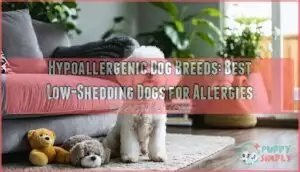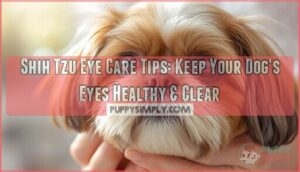This site is supported by our readers. We may earn a commission, at no cost to you, if you purchase through links.

These dogs don’t shed as much and produce less dander – the tiny skin flakes that trigger most allergies.
Breeds like Poodles, Maltese, and Portuguese Water Dogs have hair instead of fur, which means fewer allergens floating around your home.
While no dog is completely allergen-free, these breeds can reduce your exposure by up to 90%.
Think of them as nature’s compromise for dog lovers with sensitive noses.
The secret lies in understanding which specific traits make certain breeds better choices for allergy sufferers.
Table Of Contents
- Key Takeaways
- Hypoallergenic Dog Basics
- Choosing Hypoallergenic Breeds
- Small Hypoallergenic Dog Breeds
- Large Hypoallergenic Dog Breeds
- Managing Allergies With Hypoallergenic Dogs
- Frequently Asked Questions (FAQs)
- Which dog is the most hypoallergenic?
- Is any dog 100% hypoallergenic?
- What is the most low maintenance hypoallergenic dog?
- Can hypoallergenic dogs still trigger other allergies?
- How much do hypoallergenic breeds typically cost?
- Are there hypoallergenic dog foods available?
- Do hypoallergenic dogs require special veterinary care?
- Which hypoallergenic breeds are best for apartments?
- Conclusion
Key Takeaways
- You don’t need to avoid dogs completely – hypoallergenic breeds can reduce allergen exposure by up to 90% through minimal shedding and less dander production.
- Hair beats fur for allergy relief – breeds like Poodles, Maltese, and Portuguese Water Dogs have hair instead of fur, which traps allergens rather than releasing them into your home.
- Regular grooming is essential – you’ll need to brush your hypoallergenic dog weekly and bathe them with allergen-reducing shampoo to maintain their low-allergen benefits.
- Test before you commit – spend time with potential breeds first, since individual reactions vary, and even hypoallergenic dogs aren’t 100% allergen-free.
Hypoallergenic Dog Basics
If you’re among the estimated 10-20% of people allergic to dogs, you don’t have to give up your dream of pet ownership.
Hypoallergenic dog breeds produce less dander and shed minimally, making them better choices for allergy sufferers who want a furry companion.
What Causes Dog Allergies
Your immune system mistakes harmless proteins from dogs as dangerous invaders, triggering allergic reactions.
Dog dander, canine saliva, and urine contain these allergens that cause pet allergies. When you breathe in or touch these allergen triggers, your body produces antibodies.
This creates symptoms like sneezing and watery eyes that make life tough for allergy sufferers. Understanding common allergy types is essential for managing pet allergies effectively.
Low-Shedding Breeds Benefits
Low-shedding dogs offer significant advantages for allergy sufferers.
Their hypoallergenic dog breeds produce less dander, providing natural allergy relief through better shedding control.
Their breathable coats trap fewer allergens than traditional fur.
Non-shedding dogs require less frequent vacuuming and pet care maintenance.
You’ll find low-allergen dogs create cleaner indoor environments.
Hypoallergenic puppies grow into manageable companions for sensitive households, making them ideal for families with allergy concerns, and they are often considered hypoallergenic.
Dander and Allergen Reduction
Regular pet grooming cuts dander levels by up to 85%, making hypoallergenic dog breeds even more effective for allergy sufferers.
You’ll want to bathe your nonshedding dogs weekly with allergen-reducing shampoo for ideal dander control.
HEPA air purifiers capture 99.7% of airborne particles, including microscopic dander from lowallergen dogs.
Breed selection matters—danderfree dogs with predictable coats produce fewer allergens than mixed breeds, making allergen tests more reliable for determining compatibility.
Understanding pet dander risks is vital for minimizing allergic reactions in households with pets.
Choosing Hypoallergenic Breeds
When you’re choosing a hypoallergenic dog breed, purebred dogs offer the most predictable results for allergy sufferers since their coat types remain consistent across generations.
You’ll want to focus on specific breed characteristics like coat texture, grooming needs, and size to find the perfect match for your lifestyle and allergy sensitivity.
Purebred Dogs for Allergy Sufferers
Choosing purebred dogs often provides the best outcome for allergy sufferers since these breeds have predictable coat types.
Breeding methods guarantee consistent traits across generations, making breed selection more reliable than mixed breeds.
Consider these factors:
- Allergy testing with specific breeds before committing
- Dog dander levels vary between purebred lines
- Pet hair consistency helps predict allergic reactions
Hypoallergenic dog breeds like nonshedding dogs offer the best dogs for allergies, especially hypoallergenic puppies from established lowallergen dogs.
Breed Characteristics and Traits
When choosing hypoallergenic dog breeds, you’ll find coat types vary dramatically—from Poodles’ curly locks to Schnauzers’ wiry textures.
These nonshedding coats trap dander instead of releasing it into your home. Breed sizes range from tiny Yorkshire Terriers to giant Schnauzers, all sharing similar shedding patterns that minimize allergy triggers.
Lowallergen breeds consistently produce fewer airborne particles than traditional dogs. Understanding hypoallergenic characteristics is essential for making an informed decision about the best breed for your needs, especially considering allergy triggers and nonshedding coats.
Small Hypoallergenic Dog Breeds
If you’re looking for a smaller companion that won’t trigger your allergies, several small hypoallergenic breeds offer the perfect solution.
These compact dogs typically weigh under 25 pounds and produce minimal dander while still providing all the love and personality you’d expect from a loyal pet, making them a great choice for those seeking hypoallergenic companions.
Yorkshire Terrier Characteristics
The Yorkshire Terrier’s fine, human-like hair makes it one of the top hypoallergenic dog breeds for allergy sufferers.
These small dogs shed minimally, requiring consistent Yorkshire Terrier grooming to maintain their nonshedding coats.
Key Yorkshire Terrier characteristics include:
- Yorkie Temperament: Loving yet lively personality
- Terrier Training: Responds well to consistent, positive reinforcement
- Small Dog Care: Requires daily brushing to prevent matting
- Yorkie Grooming: Professional grooming every 6-8 weeks recommended
- Dog Nutrition: Small kibble size suits their tiny mouths perfectly
Maltese and Havanese Breeds
Beyond their tiny size, Maltese and Havanese breeds offer distinct advantages for allergy sufferers.
The Maltese features silky, human-like hair that requires regular Maltese grooming but produces minimal dander.
Havanese dogs have longer, flowing coats with different hair texture that also shed less.
Both hypoallergenic dog breeds need consistent care, though Havanese training tends to be easier due to their willing-to-please nature.
Proper dog grooming tools are essential for maintaining their coats, which is a key aspect of dog grooming and requires the right grooming tools.
Shih Tzu and Miniature Schnauzer
Both breeds make excellent choices for allergy sufferers.
The hypoallergenic Shih Tzu requires regular grooming to prevent matting, while the hypoallergenic Miniature Schnauzer responds well to training.
Dog allergy tests can help determine your compatibility with these low-shedding dogs.
Pet care tips include frequent brushing for both allergy-friendly dogs.
These small hypoallergenic dogs offer different personalities but similar benefits through breed comparison studies.
Large Hypoallergenic Dog Breeds
If you’re looking for a larger companion that won’t trigger your allergies, several big dog breeds produce less dander than their shedding counterparts.
These gentle giants combine impressive size with coats that trap allergens instead of spreading them throughout your home, making them a suitable choice for those with allergies who still want a larger companion.
Standard Poodle and Giant Schnauzer
Standard Poodles and Giant Schnauzers rank among the most intelligent hypoallergenic dog breeds.
Standard Poodles require specialized Poodle Grooming every 6-8 weeks, while Giant Schnauzers need consistent Schnauzer Training due to their size.
Both breeds benefit from quality hypoallergenic dog food and regular Pet Care routines. Proper nutrition is key, and owners should research hypoallergenic food options to guarantee the best diet for their pets.
- Standard Poodles: Second smartest breed, low-shedding coats, excel in obedience training
- Giant Schnauzers: Loyal guardians up to 75 pounds, moderate grooming needs, task-focused intelligence
- Breed Comparison: Both require active owners who can provide mental stimulation and exercise
Portuguese Water Dog and Irish Terrier
These medium-to-large hypoallergenic dog breeds offer unique benefits for allergy sufferers.
Portuguese Water Dogs feature curly coats that trap dander, requiring regular Portuguese Grooming to maintain their hypoallergenic properties.
Their Water Dog Health needs include daily exercise and proper nutrition.
Irish Terriers have wiry coats that shed minimally, making them excellent lowshedding dogs.
Irish Training helps manage their spirited nature.
When comparing these hypoallergenic dogs, both breeds require consistent care but reward owners with loyal companionship and reduced allergen exposure.
Understanding hypoallergenic characteristics is vital for making informed decisions about the right breed for your family.
Afghan Hound and Airedale Terrier
If you’re looking for regal beauty, Afghan Hounds offer stunning long coats with minimal shedding but need extensive Afghan Grooming.
Airedale Terriers, known as "The King of Terriers," provide easier maintenance with their wiry coats.
Both hypoallergenic dog breeds require consistent Airedale Training and regular Hound Exercise for ideal Terrier Health.
Managing Allergies With Hypoallergenic Dogs
Managing your allergies with hypoallergenic dogs still requires proper care and attention to minimize reactions.
Regular grooming and understanding severe allergy symptoms will help you enjoy life with your low-shedding companion.
Regular Grooming and Dander Reduction
You’ll want to brush your hypoallergenic dog breeds regularly to remove loose hair before it spreads around your home.
Weekly brushing sessions help with dander control and shedding reduction.
Professional grooming every 6-8 weeks keeps coats healthy and minimizes allergens.
Regular baths with hypoallergenic shampoo support allergen minimization.
Proper coat maintenance makes low-shedding dogs even more dander-free for sensitive family members.
Understanding the hypoallergenic dog breeds is essential for effective allergy management and pet care.
Severe Allergy Symptoms and Solutions
When severe reactions strike, you’ll need swift action to protect your health.
Even hypoallergenic dog breeds can trigger intense responses in highly sensitive allergy sufferers.
Here’s your emergency game plan:
- Allergy Testing: Get tested for specific dog allergens to identify triggers
- Medical Treatment: Use antihistamines, corticosteroids, or immunotherapy for symptom relief
- Allergen Avoidance: Create breathable environments with HEPA filters and restricted dog access
- Emergency Protocol: Know when breathing difficulties require immediate medical attention
Effective allergy management often involves using the right allergy medication to alleviate symptoms.
Frequently Asked Questions (FAQs)
Which dog is the most hypoallergenic?
No dog is 100% hypoallergenic, but hairless breeds like the Xoloitzcuintli and Chinese Crested come closest.
Poodles, Portuguese Water Dogs, and Maltese also produce minimal dander, making them excellent choices for allergy sufferers.
Is any dog 100% hypoallergenic?
No dog is 100% hypoallergenic. All dogs produce dander, saliva, and urine that can trigger allergic reactions. However, some breeds produce fewer allergens, making them better choices for people with allergies.
What is the most low maintenance hypoallergenic dog?
Basenji dogs require minimal grooming with their short, fine coats and self-cleaning habits.
They’re naturally clean, shed very little, and don’t need regular brushing, making them ideal for busy owners seeking hypoallergenic companions.
Can hypoallergenic dogs still trigger other allergies?
Mary thought her Poodle was the perfect solution until she started sneezing around outdoor pollen that clung to his curly coat.
Yes, hypoallergenic dogs can still trigger other allergies through environmental allergens they carry indoors on their fur, which can be a significant issue for people with allergies.
How much do hypoallergenic breeds typically cost?
You’ll pay between $500 and $2,500 for most allergy-friendly pups, with $1,700 being the average. Quality show dogs cost more, while shelter adoption saves cash.
Are there hypoallergenic dog foods available?
After Jake’s chocolate lab started scratching constantly, switching to specialized dog foods helped manage his allergies.
Yes, many brands offer limited-ingredient and hydrolyzed protein formulas specifically designed for dogs with food sensitivities and allergies.
Do hypoallergenic dogs require special veterinary care?
You don’t need special veterinary care for hypoallergenic dogs.
They require the same routine checkups, vaccinations, and preventive treatments as any other breed.
However, their grooming needs are typically higher to maintain their low-shedding coats.
Which hypoallergenic breeds are best for apartments?
Like finding a needle in a haystack, you’ll discover several hypoallergenic breeds thrive in apartments.
Bichon Frise, Maltese, Havanese, and Yorkshire Terriers adapt well to smaller spaces while producing minimal dander for allergy sufferers, making them ideal for those who want minimal dander.
Conclusion
Finding the right dog is like discovering a key that opens happiness without triggering your allergies.
These hypoallergenic dog breeds offer hope for allergy sufferers who refuse to give up their dream of pet ownership.
By choosing low-shedding breeds and maintaining proper grooming routines, you can substantially reduce allergen exposure in your home.
Remember that individual reactions vary, so spend time with potential breeds before committing, and with patience and the right match, you’ll find a loyal companion that won’t leave you reaching for tissues.
- https://www.petmd.com/dog/general-health/hypoallergenic-dogs
- https://www.thesprucepets.com/hypoallergenic-dog-breeds-5181208
- https://pacagen.com/blogs/dog-allergies/the-best-hypoallergenic-non-shedding-dog-breeds-for-families-and-active-households
- https://hfu.hollywoodfeed.com/hypoallergenic-dogs-breeds-benefits-and-care/
- https://www.zerorez.com/blog/hypoallergenic-dog-breeds














